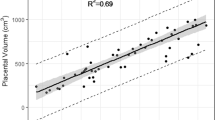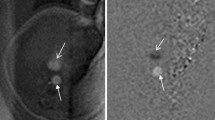Abstract
Objective:
In comparison with standard two-dimensional (2D) imaging of fetal structure and biometry, we aimed to evaluate the role of three-dimensional (3D) imaging as a screening tool in the mid-trimester.
Study design:
Pregnant women presenting between 18and 22 weeks for routine anatomical survey and biometric measurements were recruited. Six volumes of fetal anatomic regions were obtained and archived for later reconstruction, along with three volumes of extra-fetal structures (placenta, cervix, amniotic fluid). The 2D standard fetal images were then obtained. Offline reconstruction of 3D volumes was performed for comparative analysis (2D vs 3D). Subsequently, 3D volumes were reconstructed to mirror traditional 2D and allow biometric comparison between the two techniques. Data of 98 patients were analyzed.
Results:
Complete visualization of vital anatomic structures was seen ⩾85% of the time with 3D ultrasound. The 3D imaging improved the assessment of the four heart chambers (P=0.003), thoracic spine (P=0.008) and lumbar spine (P=0.012) views. The 2D imaging was superior for the fetal head, placenta and upper limbs. Conditional probabilities were used to assess the clinical value of 3D when standard 2D views were incomplete (mean 0.8830; 95% confidence interval 0.8059 to 0.9320). Overall diagnostic accuracy of 3D ultrasound is not superior for all fetal anatomic structures. Fetal biometric measurements assessed by both techniques demonstrated substantial to excellent agreement.
Conclusion:
The use of 3D imaging as a primary screening tool is limited and may be best utilized as a second-stage test. Overall, there is good correlation between fetal biometry assessed by either 2D or 3D technology.
This is a preview of subscription content, access via your institution
Access options
Subscribe to this journal
Receive 12 print issues and online access
$259.00 per year
only $21.58 per issue
Buy this article
- Purchase on Springer Link
- Instant access to full article PDF
Prices may be subject to local taxes which are calculated during checkout



Similar content being viewed by others
References
Dyson RL, Pretorius DH, Budorick NE, Johnson DD, Sklansky MS, Cantrell CJ et al. Three-dimensional ultrasound in the evaluation of fetal anomalies. Ultrasound Obstet Gynecol 2000; 16 (4): 321–328.
Rizzo G, Pietrolucci M, Aiello E, Mammarella S, Bosi C, Arduini D . The role of three-dimensional ultrasound in the diagnosis of fetal congenital anomalies: a review. Minerva Ginecol 2011; 63 (5): 401–410.
Rizzo G, Abuhamad AZ, Benacerraf BR, Chaoui R, Corral E, Addario VD et al. Collaborative study on 3-dimensional sonography for the prenatal diagnosis of central nervous system defects. J Ultrasound Med 2011; 30 (7): 1003–1008.
Nelson TR, Pretorius DH, Lev-Toaff A, Bega G, Budorick NE, Hollenbach KA et al. Feasibility of performing a virtual patient examination using three dimensional ultrasonographic data acquired at remote locations. J Ultrasound Med 2001; 20 (9): 941–952.
Merz E, Abramowicz JS . 3D/4D ultrasound in prenatal diagnosis: is it time for routine use? Clin Obstet Gynecol 2012; 55 (1): 336–351.
Benacerraf BR, Shipp TD, Bromley B . Three-dimensional US of the fetus: volume imaging. Radiology 2006; 238 (3): 988–996.
Baumler M, Faure JM, Bigorre M, Baumler-Patris C, Boulot P, Demattei C et al. Accuracy of prenatal three-dimensional ultrasound in the diagnosis of cleft hard palate when cleft lip is present. Ultrasound Obstet Gynecol 2011; 38 (4): 440–444.
Sarris I, Ohuma E, Ioannou C, Sande J, Altman DG, Papageorghiou AT et al. Fetal biometry: how well can offline measurements from three-dimensional volumes substitute real-time two-dimensional measurements? Ultrasound Obstet Gynecol 2013; 42 (5): 560–570.
American Institute of Ultrasound in Medicine. AIUM practice guideline for the performance of an antepartum obstetric ultrasound examination. J Ultrasound Med 2003; 22 (10): 1116–1125.
Cargill Y, Morin L, Bly S, Butt K, Denis N, Gagnon R et al. Content of a complete routine second trimester obstetrical ultrasound examination and report. J Obstet Gynaecol Can 2009; 31 (3): 272–275, 276–280.
Durkalski VL, Palesch YY, Lipsitz SR, Rust PF . Analysis of clustered matched-pair data. Stat Med 2003; 22 (15): 2417–2428.
Schwarzler P, Senat MV, Holden D, Bernard JP, Masroor T, Ville Y . Feasibility of the second-trimester fetal ultrasound examination in an unselected population at 18, 20 or 22 weeks of pregnancy: a randomized trial. Ultrasound Obstet Gynecol 1999; 14 (2): 92–97.
Tonni G, Grisolia G, Sepulveda W . Second trimester fetal neurosonography: reconstructing cerebral midline anatomy and anomalies using a novel 3-dimensional ultrasound technique. Prenat Diagn 2014; 34 (1): 75–83.
Acknowledgements
We thank Dr Monica Taljaard from the Ottawa Hospital Research Institute for her assistance with the statistical analysis. ZMF holds a Canadian Institute of Health Research (CIHR) Postdoctoral Fellowship. The study was funded by The Ottawa Hospital Academic Medical Organization (TOHAMO).
Author information
Authors and Affiliations
Corresponding author
Ethics declarations
Competing interests
The authors declare no conflict of interest.
Rights and permissions
About this article
Cite this article
Roy-Lacroix, M., Moretti, F., Ferraro, Z. et al. A comparison of standard two-dimensional ultrasound to three-dimensional volume sonography for routine second-trimester fetal imaging. J Perinatol 37, 380–386 (2017). https://doi.org/10.1038/jp.2016.212
Received:
Revised:
Accepted:
Published:
Issue Date:
DOI: https://doi.org/10.1038/jp.2016.212



